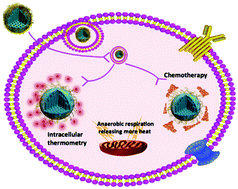An engineered thermo-sensitive nanohybrid particle for accurate temperature sensing at the single-cell level and biologically controlled thermal therapy†
Abstract
Medical applications of nanotechnology typically focus on biosensors and drug delivery. Here, we combine nanotechnology and chemical synthesis to create a novel type of thermo-sensitive nanohybrid (CD-MSN@UP38) particle for intracellular temperature sensing and temperature-controlled drug release, which could lead to new cancer diagnosis techniques and therapies. The nanohybrid particles were first developed as a sensitive thermometer by loading them with a polarity-sensitive dye (BBD). The presented thermometer possessed high temporal resolution and temperature resolution down to 0.2 °C; combined with fluorescence lifetime imaging microscopy, the particles are well suited for mapping and sensing temperature distributions at the single-cell level. More interestingly, the nanohybrid particles can be further applied as a smart temperature-controlled drug delivery system for cancer therapy, through simply being triggered by the thermal effects of the cancer cells themselves. Our drug delivery and therapy system demonstrates highly efficient therapeutics with minimal side effects.


 Please wait while we load your content...
Please wait while we load your content...